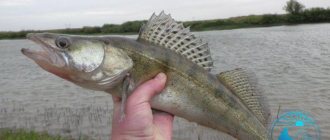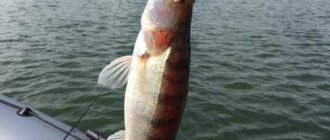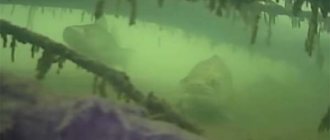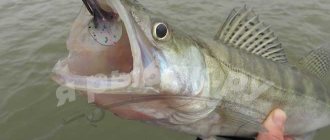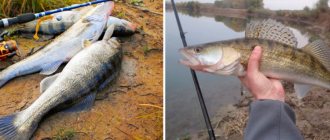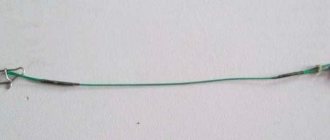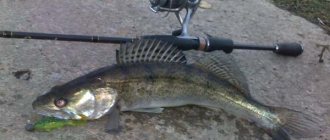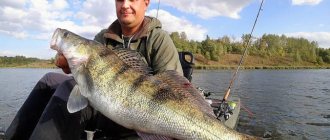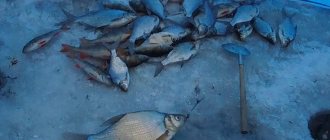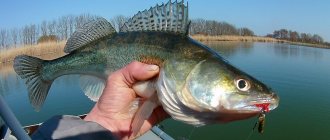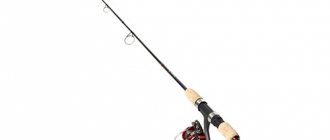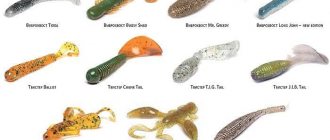Catching pike perch at night with a spinning rod is practiced by few anglers. This is a difficult type of fishing that requires a fair amount of experience, knowledge and practical skills. It is difficult for novice spinning anglers to take basic successful steps in night pike perch hunting, since they do not have enough information about the habits of the fanged fish, its taste preferences, and behavioral characteristics in the dark period of the day. Successful fishing for pike perch at night is not possible on every body of water. In some areas that seem promising at first glance, hunting in the dark does not give the expected result. In other places, on the contrary, the fanged one actively feeds and is easy to catch.
Peculiarities of pike perch behavior at night
Pike perch is considered a nocturnal schooling predator. After sunset, this fish becomes active, moves around the water area and hunts for small, narrow-bodied fish. The fanged one is most active at dawn, as well as around midnight. During other hours, the fish experience a slight decrease in appetite. Pike perch begins to fish for spinning at night in the spring, when it begins its pre-spawning run. During this period, many fishermen, not waiting for the fanged fish to emerge at dawn, pack up and leave the reservoir. Experienced spinning anglers linger on the shore for an hour. Often this bears fruit in the form of several confident bites and weighty fish.
At the end of spring after spawning, the fanged fish gradually switches to a summer feeding regime. During the day, the predator is active with short-term exits. Pike perch are most active at night. It reaches various shallow sections of rivers, where whitebait accumulate in abundance. In autumn, pike perch continues to be caught at night. Few fishermen know about this and are content with only daylight hours. However, in the dark, it is the trophy specimens that are caught that are reluctant to take bait during the day. In ice-free sections of rivers, fishing for pike perch at night in winter is practiced, and quite successfully. There are still few fans of winter spinning rods, since fishing is difficult, not everyone can withstand the cold and other “delights” of winter. But there are no barriers for fans of paddle boarders; they go to the river at any time of the year.
Fishing tactics and tips
You cannot provide all possible fishing options and fishing spots, but there are recommendations that should always be followed:
- until it is determined where the fish are biting, the donks must be cast at different distances from the shore;
- Donks thrown at different distances will allow you to control schools of pike perch from the moment they leave the depths until the moment they return to the pits;
- the determining factor for success during night fishing with jigs and retractable leash is complete control over the retrieve;
- for night fishing it is necessary to prepare a place during the day - most baits break off on the shore at night;
- A fisherman’s equipment at night must necessarily include several lighting sources, mosquito repellents, warm clothing, light and sound alarms for donks;
- To achieve success in hunting pike perch using a spinning rod, it is advisable to practice blind fishing during the day, i.e. check the gear for sensitivity without vision;
- night pike perch often bite more confidently and sharply than daytime pike perch, so the angler should always be prepared for a sharp and clear hook;
- Every change in the game of the bait should end with a hook;
- When fishing for a “passive” pike-perch, you must not relax until the moment when the fish is in your hands or in the padnet – the fanged one is capable of starting a fight right next to the shore.
An indisputable fact is the success of catching pike perch at night. But you don’t need to think that the pike perch itself will cling to the hook. To ensure success, careful study of fishing areas and preparation of gear is necessary.
Features of catching pike perch at night using a spinning rod in summer
Summer is the most favorable period for night hunting for pike perch. It is easiest to catch a fanged one in the warm season in the dark. The main peaks of predator activity on a summer night occur at the following hours: • 22–23 hours, the first burst of bites, starting at sunset and lasting about an hour, • immediately after midnight. The exit lasts about an hour. This is the most exciting period in summer night fishing, • 3–4 o'clock in the morning before sunrise. As it gets lighter, the bite subsides, and by 5–6 am it subsides. Catching pike perch at night in the summer causes the least amount of difficulty for beginners, so it is better to master this area of fanged hunting in the warm season.
Choosing a fishing spot
A special feature of summer night pike perch fishing is the emergence of fish in shallow sections of rivers. Often fanged fish are caught in typical places: • sand spits and shallows, • shallow riffles with a rocky, pebble or sandy bottom, • shallow areas near hydraulic structures. Pike perch likes to feed in the area of stone embankments that reinforce the banks. Actively hunts in the coastal zone near bridge supports and in the area of piers. In summer, fishing for pike perch at night from the shore is practiced. There is no need for a boat as most of the typical sites listed above are within reach from land. Any bait can be thrown to a promising point without resorting to the services of watercraft.
Lures
The best baits for night pike-perch fishing are shallow-water minnow-class wobblers. They imitate the food item of a predator as closely as possible: • an elongated body, its shape imitating a narrow-bodied fish, bleak, perch, chub or roach. • rudimentary blade defining the subsurface working horizon. • the wobbler's action is realistic, reminiscent of a fish running away or losing its orientation. These bulky baits go at shallow depths. The working range is in the range of 5–40 cm. This is enough to fish shallow water areas into which a predator jumps out and grabs the fry that has accumulated there.
Not every shallow-water minnow is suitable for catching pike perch. The wobbler must meet the following requirements: • length 7–11 cm. There will be little grip on a larger bait, • the presence of its own game is mandatory, since the optimal movement of the wobbler for night pike perch will be uniform or uniform with pauses, • type of buoyancy – floating. In order to be able to make long stops in the middle of the drive, • the ability to work in the current. One of the best wobblers for catching large pike perch is the Barra Magnum from Rapala. The bait has a length of 110 mm, which arouses the interest of a large predator. Most often, fish bite when the wobbler hits the bottom.
Less commonly, the predator is caught with crank-class wobblers. Shallow-water lures SSR are used - Super Shallow Runner, which do not go deeper than 30 cm (for example, Jackall Chubby 38F SSR wobbler). They are good in cases where the fish are reluctant to grab quiet minnows. Therefore, it is appropriate to try to persuade her with the help of noisy stubborn pot-bellied fats. Rubber baits produce good results. Twisters and vibrating tails measuring 3-4 inches are used. They are mounted on open jig heads of the minimum possible weight so that they work in the top layer. The best ways to wire silicone are wavy and uniform. The line of the famous soft bait manufacturer Lucky John includes the Zander series, designed specifically for catching pike perch. This is a relatively new development of lures of this kind, and manufacturers, when recommending it to users, assure that pike perch will willingly take it precisely because they are not yet familiar with this model and will not feel the danger posed by it.
Spinners and topwaters can also be used for night fangs. However, they are inferior in efficiency to wobblers and silicone. It is better to take them with you to the pond as an alternative when the pike perch ignores the usual baits.
Features of catching pike perch at night in autumn
With the onset of September, pike perch gradually switches to the autumn feeding regime. He rarely raids shallow water areas anymore. Many zanders in the fall hunt for fanged jigs exclusively during daylight hours. However, the predator continues to actively feed at night, but no longer in shallow water. Catching pike perch at night in autumn is not tied to dawn, as was observed in summer. Different sections of rivers have their own characteristics in the habits of the predator. In some places it becomes active immediately after sunset, in others a surge in appetite occurs at midnight. Therefore, without a thorough knowledge of the places and the specific behavior of the fish, you can’t count on a catch.
Places to catch autumn pike perch at night
In autumn, the fanged one hunts in the bottom layer at night. You need to forget about various shallows and small riffles. You should not look for an active predator in holes or snags, where it is successfully caught during the day. Typical areas where you can catch pike perch at night are: • sharp coastal edges and drop-offs, • long uneven areas with tubercles, holes, local grooves and ridges, • single submerged trunks or large tree branches near deep areas, • in the area of piers and embankments at medium depths, • near bridge supports and other hydraulic structures. You have to catch pike perch on an autumn night from a boat, especially on large rivers and vast water areas, since promising areas are located far from the shore. There are areas that can be successfully fished without a boat, so it all depends on the specific fishing location.
Lures for catching pike perch with a spinning rod in the fall
In the autumn, fanged fish are mainly caught with a jig. This approach is the most effective and universal. There is no need to invent unnecessary things; night jig is no different from daytime fishing. The main thing in fishing for pike perch on an autumn night is to know promising points and be there at the moment the predator emerges.
Catching pike perch at night with jigs is done with classic silicone baits. In clean areas they are attached to jig heads with an open hook. In areas where snags are likely, the “rubber” is mounted on an offset hook and an eared sinker. In night jigs, serious demands are placed on gear. The fisherman is deprived of the opportunity to visually record bites and monitor the behavior of the bait. Everything is felt tactilely, so the sensitivity of the jig kit must be high. In addition to silicone, the following baits can be used for night-time autumn pike perch: • foam rubber fish, • diving crankbait wobblers, • rattlins, • front-loaded spinners. The best results come from night fishing for pike perch in October. This month, according to statistics, the largest individuals are caught. Equipment You cannot go out at night for pike perch without the correct equipment. Initially, you need to take care of the light source. It can be used as a variety of flashlights and compact lamps. Be sure to have a headlamp with spare batteries in case the main set dies in the middle of fishing. A spare flashlight wouldn't hurt. You will have to use it less often, but there is a high probability that it will come in handy.
In the warm season, the following elements of equipment will be important: • insulated clothing, since at night the temperature near the water can drop significantly. • baseball cap or cap. • insect repellents. As the weather gets colder, you should pay special attention to your clothing. Even if it’s still quite warm on an autumn day, a hat and gloves won’t hurt at night. High-quality waterproof insulated shoes deserve special attention. Boots made of “foam” with warm neoprene inserts have proven themselves to be quite good. When fishing from a boat, be sure to equip your craft with marker signals and powerful, bright lights that allow you to safely navigate the water area. The presence of an echo sounder with the functions of a chartplotter and GPS navigator is desirable for easy detection of promising points, finding the correct path in large locations, displaying the structure and topography of the bottom, and remembering routes. In conclusion, fishing for pike perch using a spinning rod at night is different from daytime fishing. It allows you to get new emotions from hunting for fanged animals and take a different look at this desired predator. This is a difficult spinning direction, but it can be mastered, because nothing is impossible for a passionate fisherman.
Recommendations
You can fish vertically throughout the year, but the highest catches of the fanged predator can be obtained in late autumn, when this fish begins to eat heavily.
It is worth doing vertical fishing for pike perch in areas of the reservoir with a rocky bottom. In such places, when casting spinning tackle from the shore, frequent hooks and breaks of the tackle occur, which is practically eliminated when vertical trolling from a boat or cutter.
When fishing for predatory fish this way, the spoon is tied to the main fishing line without the use of leashes. Even if such a toothy predator as a pike lives in the reservoir. When fishing vertically, the hooking of the fish is carried out instantly and in most cases, even the pike does not manage to gnaw the line, due to the vertical rise of the fish and the predator not swallowing the bait too deeply.
If it is not possible to purchase or rent a watercraft, then good results can be obtained by vertical fishing from some hydraulic structure, for example, a bridge or dam.
When hunting for pike perch from a boat in a plumb line, you can do without a rod and reel at all; just wind the required amount of fishing line on a reel, tie a spoon, and you can fish by hand. With this method of fishing, you should use a fishing line with a diameter of at least 0.5 mm, so as not to cut your hands when fishing for trophy fish. If a rubber inflatable boat is used, then this method should be abandoned to prevent damage to the craft from sharp hooks.
If pike perch fishing is carried out on a large body of water or on a river with intense current, then the use of a boat motor will provide high mobility and allow you to explore a large area of the lake or river.
If the fish is so passive that for a long time the fisherman has to “play” with his gear on his own, then when fishing with artificial bait, you can use the tactics that are used for catching pike perch in winter
To do this, you should tap the bait on the bottom, then slightly lift the bait, then repeat these steps again.
In order to determine promising places in a reservoir for vertical trolling, you should pay attention to sections of rivers with reverse flows and whirlpools; in reservoirs with standing water, deep holes can be identified by the absence of ripples in the water.
Catching pike perch from a boat in a vertical position can be very exciting during the post-spawning feast; at this time, a fisherman, upon discovering a school of this predator, can catch a lot of fanged predators.
It is necessary to start catching pike perch vertically only at depths of 3 meters or more; if the depth is less, then the shy fish will not take the bait, and the angler will only waste time fishing in shallow water.
If the current on the river is significant, then after the predator bites, you need to go back a little upstream and fish the lucky spot again. Pike perch very rarely travels alone, so most likely in this place there is a school that is not at all concerned about the disappearance of its fish brother, and will be interested in the bait lowered to the bottom again.
If at the fishing site there is a hole more than 12 meters deep, and no bites occur when placing the bait near the bottom, then you can try to look for pike perch in the water column
This arrangement of the bait can be very catchy, especially when fishing with live fish.
To successfully catch pike perch from a boat in a vertical position, the weather plays a big role; if it rains a little, then it is still possible to effectively catch pike perch using this method, but if a hurricane wind starts to blow and there is excitement in the reservoir, then you must stop fishing and immediately moor to the shore . Staying in open water under such weather conditions is quite dangerous.
In summer, during extreme heat, it is also not safe to be in open areas of the reservoir; moreover, predatory fish such as pike perch and perch often stand in the shade of trees or bridges at such times. If there is a hole in such places, then the chance of catching a large representative of this type of fish increases many times over.
When fishing vertically, the intensity of movement of the rod should be selected based on the water temperature. In cold water, sudden movements of the bait can even scare off a predator; in summer, on the contrary, it is necessary to manipulate the bait much more sharply.
